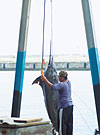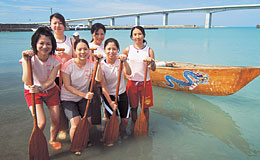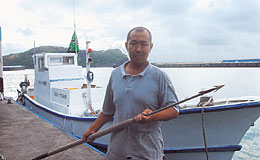Special Feature![]() Okinawa’s Beautiful Sea
Okinawa’s Beautiful Sea

Living with the Sea
There is an old Okinawan saying, “Happiness comes from the sea.” The sea provides salt, fish and other products, and it keeps inspiring admiration and a desire to conserve its blessings. The lives of people on these pages are all influenced by the sea in one way or another.
Precision teamwork speeds them across the water
The Pink Pandas of the Takara Harii Rowing Club
Okinawa’s traditional harii 10-man rowboat races were once held by fishermen to ask the heavens for safety at sea and a good catch. The races continue today, but the sporting element has grown stronger. In the old days, it was only men who rowed, but about a decade ago women teams began racing too, and today “madonna races” are a big attraction in many parts of Okinawa.
One women’s group, the Pink Pandas from the Takara Harii Rowing Club, is based in the fishing port of Yone in Tomigusuku, near the southern tip of the main island of Okinawa. The team is a powerhouse, a champion at madonna races. They practice three times a week after work, rowing out from the port to a designated place offshore then back again, time after time for two hours straight. When they get everything in unison—even their breathing—the boat speeds forward unbelievably quickly.
“With each stroke of the oars, it’s like the boat jumps out of the water for an instant. When it feels like we’re flying over the sea, rowing as one person, we really know why we row,” says the team captain, Minei Akiko.
Good times and bad, every moment is a moment to share. Team members say they developed an even greater love of the sea after they took up harii racing.
When a big one pulls hard on the longline
Blue marlin fisherman, Nakajima Katsuji
Yonaguni-jima is Japan’s most westerly island, and it is famous for the kajiki-maguro blue marlin caught around it. For years, fishermen from the Yonaguni Fisheries Cooperative have competed, hoping for the big one.
Nakajima Katsuji is a member of the cooperative. He moved to the island from Osaka seven years ago at the age of 35, after winding down his convenience store business. He switched careers, becoming a fisherman. “Even before I settled here, I’d come once a year to fish for blue marlin—I was that keen on longlining for them. After a while I knew I wanted to be a fisherman. And I thought that if I didn’t switch careers in my 30s I probably never would.” He married on the island, and now has a daughter.
He says the best part of fishing for marlin is the strong fight they put up when hooked. For bait he uses a whole bonito, a big fish in itself. When a blue marlin takes it, the reaction on his longline is stupendous. He reels in the line a little, then lets it go slack when the time is right. He keeps this up, playing with the fish, until he senses it is tired out. Then at the right moment, he reels it in and finishes it off with his harpoon. “Even a small one, say around 90 kg, will fight for 30 or 40 minutes before I can harpoon it.” The biggest blue marlin caught by someone from the Yonaguni Fisheries Cooperative weighed 700 kg. Nakajima has set his sights on getting an even bigger one, some day.

